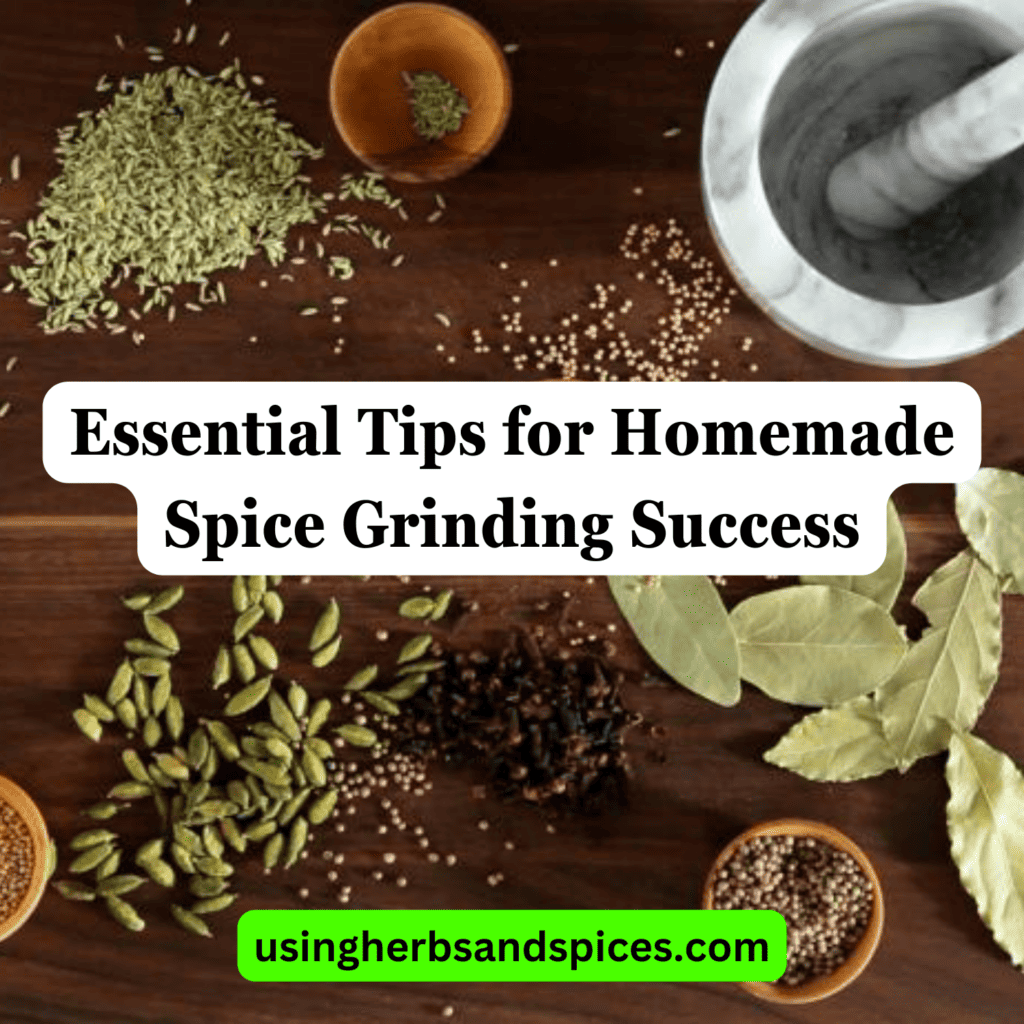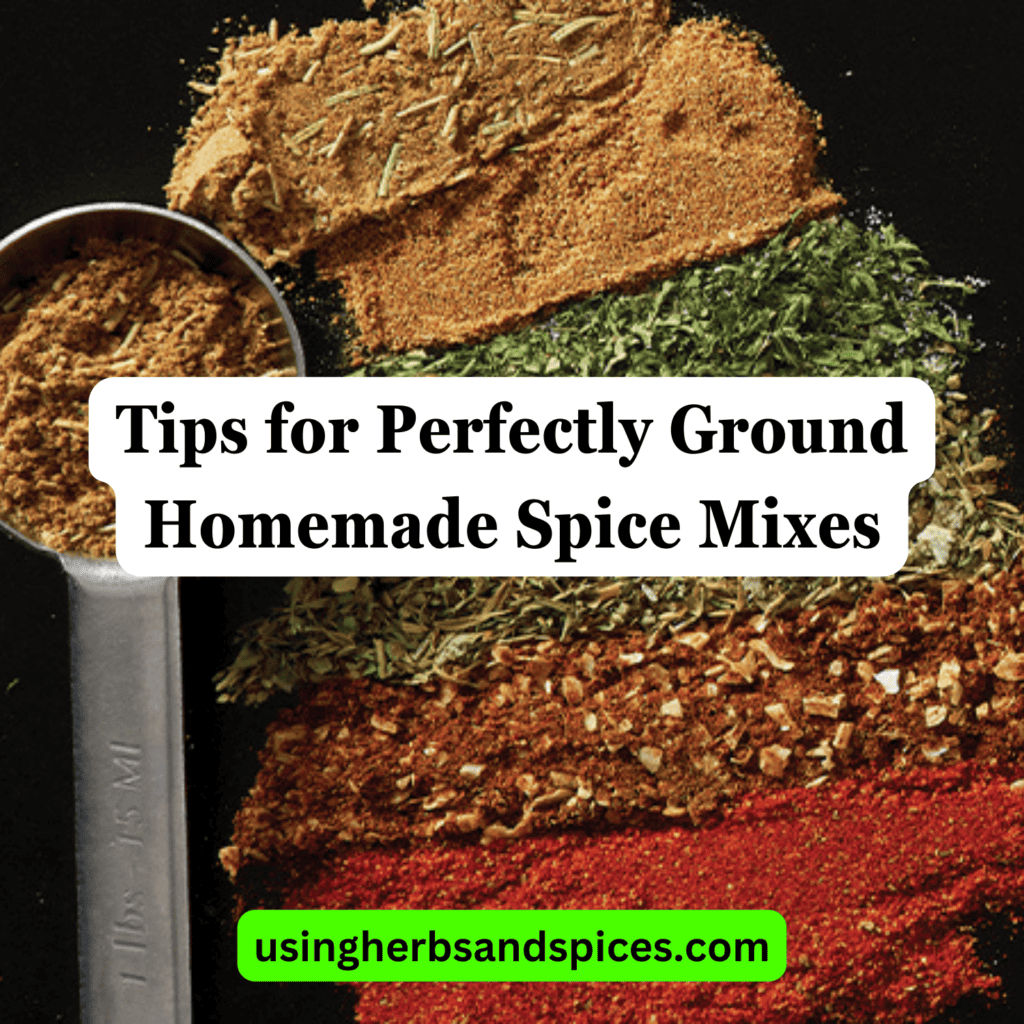Just as you’ve been seeking a deeper connection to your cooking, the Spice Grinding Toolkit comes along, promising to usher you into a community passionate about flavors.

You’re not alone in your quest for that perfect blend that turns a meal into an experience. With this guide, you’ll discover the nuances of selecting and maintaining the right grinders, whether you’re drawn to the tactile pleasure of manual grinding or the efficiency of an electric mill.
You’ll learn to appreciate the textures and qualities of different spices, mastering the art of blending them into unique flavors that speak to your palate.
As you journey through these pages, you’ll find yourself part of a flavorful adventure, surrounded by fellow enthusiasts who savor the aroma and taste of freshly ground spices, just like you.
Table of Contents
Key Takeaways
- Select the right grinder based on the desired material (stainless steel for durability or ceramic for preserving spice purity) and prioritize durability in construction.
- Consider your cooking style when choosing between manual and electric grinders, with manual grinders offering a more personalized touch and electric grinders providing convenience and quick results.
- Both manual and electric grinders have their advantages, with manual grinders offering a traditional, hands-on approach and superior precision in flavor control, while electric grinders prioritize convenience and speed.
- Regular cleaning and occasional servicing are necessary for grinder longevity, ensuring pure flavors and excellent spice grinding results.
Selecting the Right Grinders
Choosing the right grinder is essential to unlocking the full potential of your spices. The journey to the perfect blend begins with understanding grinder materials and durability concerns. You’re not just picking a tool; you’re embracing an ally in the art of flavor.
Grinder materials range from stainless steel to ceramic, each with its unique advantages. Stainless steel is the stalwart companion in your spice journey—resilient and ready for any challenge. Its resistance to rust and corrosion promises longevity, ensuring you’re never without the means to coax out those enchanting aromas.
Meanwhile, ceramic grinders offer a touch of finesse, their non-reactive nature preserving the purity of delicate spices. These materials aren’t just functional; they’re an extension of your culinary identity.
Durability concerns are paramount, as your grinder must withstand the test of time and use. A robust grinder becomes a cherished member of your kitchen ensemble. Seek out sturdy construction and a reliable mechanism, qualities that embody a grinder built to endure.
The right choice will share in countless moments of creation, standing by you as you explore the rich tapestry of flavors that spices bring to your table.
Manual Vs. Electric Options
As you explore the realms of spice grinding, you’ll encounter a pivotal choice: manual or electric grinders.
Each option offers a distinct level of flavor control precision, with manual grinders demanding more physical effort but often rewarding you with a finer, more personalized touch.
Electric grinders, on the other hand, boast ease of use, allowing for quick, consistent results with just the push of a button.
Ease of Use
Your choice between manual and electric spice grinders will significantly affect the ease and speed of your cooking prep. Manual grinders offer a traditional, hands-on approach, providing a sense of belonging to age-old culinary practices. They require more effort but give you control over the texture. Remember to prioritize grinding safety by keeping fingers clear of mechanisms.
Electric grinders, on the other hand, are about convenience and swiftness, ideal for those bustling kitchens. They can handle tougher spices with little effort. For both types, knowing a few cleaning hacks ensures longevity and pure flavors. Here’s a detailed comparison:
| Feature | Manual Grinder | Electric Grinder |
|---|---|---|
| Ease of Use | More effort, tactile experience | Less effort, push-button ease |
| Control | High – adjust grind size manually | Moderate – some have settings |
| Cleaning | Often simpler, fewer parts | Can be tricky, more components |
Choose what aligns with your cooking style, and you’ll spice up your dishes with ease.
Flavor Control Precision
You’ll find that one key advantage of manual grinders is their superior precision in flavor control, allowing you to fine-tune the coarseness of your spices to perfection. This meticulous adjustment is crucial for achieving the ideal taste balance in your culinary creations. With each twist, you’re not just grinding; you’re coaxing out the full spectrum of flavors and aroma release that can elevate a dish from good to extraordinary.
Electric grinders, while convenient, often lack this level of precision. They might offer speed, but the trade-off can be a less nuanced flavor profile. As a member of the community that cherishes every note in their food symphony, you understand that the manual process isn’t just about the grind—it’s an art form, ensuring that each dish is a masterpiece of taste and aroma.
Maintenance of Grinding Equipment
Maintaining your grinder’s longevity and performance requires regular cleaning and occasional servicing. You’re not just preserving a tool; you’re nurturing a companion that embarks with you on every aromatic adventure. Establishing diligent cleaning routines isn’t merely about hygiene—it’s an act of commitment to the craft of cooking.
Begin by disassembling the grinder post-use, brushing away residual spices, and ensuring no fragment is left behind to taint future blends.
Should your grinder falter, don’t fret. Seek repair services that specialize in culinary equipment, where artisans understand the intricacies of your beloved apparatus. They’ll tend to worn parts with precision, restoring the harmony between blade and motor. In their hands, what once faltered will find new life, ready to rejoin your kitchen’s ensemble.
Remember, a well-maintained grinder is like a treasured friend in your culinary circle. It deserves care and respect, for it holds the key to unlocking the true essence of spices. Keep it in prime condition, and it’ll ensure your creations always carry the signature of excellence.
Welcome to a world where every grind is a step towards perfecting the art of flavor.
Understanding Spice Textures
Grasping the nuances of spice textures can elevate your dishes from the mundane to the sublime. It’s about much more than simply pounding away at your ingredients; it’s an art form that requires an understanding of how texture impacts flavor release and mouthfeel.
Each spice’s granularity plays a crucial role in your culinary creations. A coarsely ground black pepper imparts a robust, sudden hit of piquancy that awakens the palate, while a finely powdered version melds seamlessly into sauces, offering an undercurrent of heat that’s essential for the dish’s identity.
When you’re part of the community that treasures the essence of spice freshness, you know that the texture of a spice can either lock in or lose those volatile oils that are the carriers of flavor. A roughly crushed cardamom pod added to your coffee or tea can transport you to an exotic locale with its bold, fragrant notes. In contrast, a finely ground cardamom can infuse your baked goods with a sweet, complex warmth that feels like a welcoming hug.
In your quest for culinary excellence, remember that the texture impact of your spices isn’t just a minor detail—it’s a cornerstone of flavor construction. You’re not just cooking; you’re crafting an experience where every grain tells a story.
Blending Spices for Unique Flavors
As you embark on the aromatic art of spice blending, understanding the principles of spice pairing is crucial. It’s about more than just combining flavors, it’s about creating a harmonious symphony.
Your grinding technique can vary dramatically. Fine powders release flavors quickly, while coarser grinds offer a delayed burst.
Keep these flavor fusion tips at your fingertips to innovate and elevate your culinary creations with each twist of the grinder.
Spice Pairing Principles
In your quest for culinary mastery, understanding how to pair and blend spices is key to unlocking complex and unique flavors. Flavor synergy and aromatic compatibility are your guiding stars as you navigate the vast universe of spices. Here are some principles to consider:
- Consider the origin of spices; regional spices often blend well together.
- Balance the flavor profiles; mix hot, sweet, tangy, and earthy notes.
- Use a focal point; choose a dominant spice and complement it with others.
- Think about the cooking process; some spices bloom in oil, others in water.
- Experiment with proportions; subtle changes can create new dimensions of taste.
Grinding Technique Variation
Your spice grinder is the key tool that unlocks the full potential of whole spices by revealing their freshest flavors and aromas. As you embark on this flavorful journey, consider how the grinding technique can influence the outcome of your blends.
Heat impact during grinding can either enhance or dull the spice’s character, so it’s pivotal to manage the friction. A slow, steady pace preserves the integrity of delicate flavors.
Aim for particle consistency to ensure even cooking and distribution of taste. Fine powders meld seamlessly into dishes, while coarser grinds add a burst of flavor with each bite.
Mastering this balance empowers you to weave a sense of belonging into your culinary creations, inviting everyone to savor the unique flavors at your table.
Flavor Fusion Tips
With a deft touch and a keen sense of taste, you’ll find blending spices to be an art form that transforms simple ingredients into culinary masterpieces. Embrace the warmth of your kitchen community as you explore the intricacies of spice toasting and aromatic layering.
Together, let’s craft a palette of flavors that resonate with the soul of home-cooked meals.
- Begin with Spice Toasting: Gently roast to unlock deep, nuanced flavors.
- Experiment with Aromatic Layering: Combine herbs and spices for complex profiles.
- Balance Heat with Sweet: Offset fiery chilis with a touch of sugar.
- Consider Texture: Mix ground spices with whole for varied mouthfeel.
- Trust Your Intuition: Let your palate guide the proportions.
Your spice blends won’t only taste divine but also weave a tapestry of shared culinary heritage.
Storing Ground Spices Efficiently
After grinding your spices, it’s crucial to store them in airtight containers away from direct light and heat to preserve their potency. The shelf life of your spices hinges on how you embrace this step. Different container types serve distinct purposes.
Glass jars with tight seals are a classic choice, offering a clear view of your aromatic treasures while locking in freshness. Alternatively, metal tins can shield spices from light, further extending their vitality.
You’re not just storing spices; you’re safeguarding the essence of your culinary creativity. As you carefully transfer your freshly ground spices into their new homes, consider labeling each container. This isn’t merely practical—it’s an invitation to connect with the flavors that define your dishes. Date the labels to track freshness, ensuring that every pinch you sprinkle is as vibrant as the day it was ground.
Nestle these containers in a cool, dark corner of your kitchen, like a dedicated spice drawer or a cabinet away from the stove. You’re not merely organizing; you’re curating a personal spice library—a collection that speaks to your unique palate. In doing so, you ensure each meal you craft is a testament to the care and passion you pour into your culinary pursuits.
Frequently Asked Questions
Can Grinding Spices in Advance Affect Their Potency Compared to Grinding Them Right Before Use?
Grinding spices in advance can lead to flavor retention issues and aroma degradation. You’ll find fresher, more vibrant tastes by grinding them just before use, connecting you with the essence of each dish.
Are There Any Health Concerns Associated With Using Pre-Owned or Second-Hand Spice Grinders?
You should be cautious with second-hand grinders. Poor cleaning practices can raise allergy risks. Always thoroughly sanitize them to ensure you’re not exposed to leftover particles from previous uses.
How Does the Material of the Grinder (Ceramic, Metal, Plastic) Impact the Flavor Profile of the Ground Spices?
The material of your grinder significantly affects flavor; for instance, ceramic retains purity, while metal may alter taste subtly over time. Material influence and grinder durability ensure you’re part of a discerning culinary community.
Is It Safe to Grind Multiple Types of Spices in the Same Grinder, and if So, How Can Cross-Contamination of Flavors Be Prevented?
Yes, you can safely grind different spices using the same grinder. To prevent flavor blending, adopt thorough cleaning methods like brushing, wiping, or grinding plain rice between uses to ensure a pure taste.
What Are the Environmental Impacts of Discarding Old or Broken Spice Grinders, and Are There Any Eco-Friendly Disposal or Recycling Options Available?
Discarding old grinders impacts the environment, but you can extend their lifespan or consider composting options for eco-friendly disposal. You’ll feel connected, knowing you’re part of a community prioritizing sustainable practices.
Grinding Toolkit
You’ve embarked on an epicurean odyssey, wielding your grinders like a flavor-wielding sorcerer. You’ve crushed, pulverized, and mastered the very essence of spices. With every twist or button press, you’ve unleashed aromatic symphonies.
Your meticulous care ensures your toolkit endures countless battles with coriander and cloves. Now, tuck away your finely ground treasures with the finesse of a spice librarian.
Relish in your newfound power; you’re not just cooking—you’re orchestrating a culinary masterpiece.









